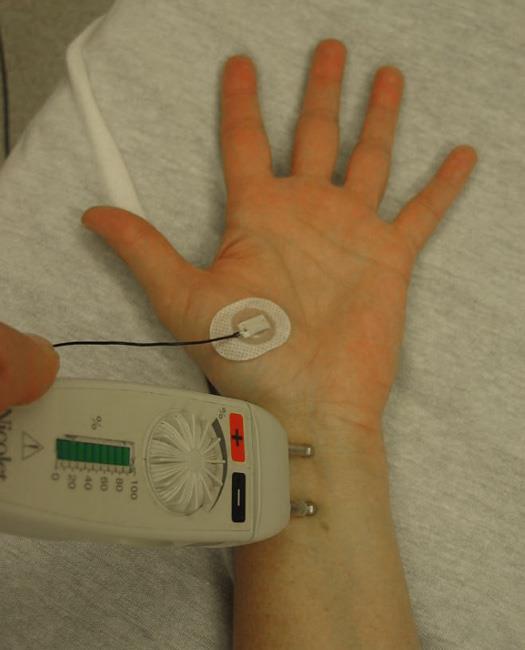Treatment
Electrodiagnostic Testing
Did you know that your body is an electrical generator? Nerves and muscles create electrical signals that deliver messages to and from your brain.
- Sensory nerves deliver information about your surroundings to the brain.
- Motor nerves deliver signals from the brain to activate your muscles.
Injuries or diseases that affect nerves and muscles can slow or halt the movement of these electrical signals. If you have pain, weakness, or numbness in your back, neck, or limbs, measuring the speed and degree of electrical activity in your muscles and nerves can help your doctor make a proper diagnosis. This process is called electrodiagnostic testing.
Two tests are commonly used:
- Electromyography (EMG)
- Nerve conduction studies (NCS)
These tests are usually administered by a neurologist (a doctor who specializes in the study of the nerves) or a physiatrist (a physical medicine and rehabilitation, or PM&R, specialist). The tests can typically be done in less than an hour.
Electromyography (EMG)
An EMG records and analyzes the electrical activity in your muscles. It is used to learn more about the functioning of nerves running from the spinal cord to the muscles. When a normal muscle is at rest, it is electrically silent.
- During an EMG, small, thin needles are placed in select muscles to record electrical activity. When the needles are inserted, you may feel some pain and discomfort.
- The doctor will ask you to relax the muscle and to tense it slightly. The doctor will listen and watch a TV-like screen that broadcasts the electrical signals. You may also be able to hear the signal sounds as you move the muscle.
If you are taking blood-thinning medications, have an illness, or are at risk for infection, tell the doctor who is conducting the test. On the day of the test, do not put any lotions or creams on the area to be tested, and do not wear any jewelry.
When the needles are removed, you may experience some soreness and bruising, but this will usually disappear in a few days. There are typically no long-term side effects.
Usually, you can get the results soon after the test.
Nerve Conduction Studies (NCS)
NCS are often done along with the EMG to determine whether a nerve is functioning normally.
- The doctor conducting the test will apply wires (electrodes) to the skin in various places along the nerve pathway.
- The doctor then stimulates the nerve with an electric current. As the current travels down the nerve pathway, the electrodes placed along the way capture the signal and time how fast the signal is traveling. In healthy nerves, strong electrical signals can travel at up to 120 miles per hour. If the nerve is damaged, however, the signal will be slower and weaker.
- By stimulating the nerve at various places, the doctor can determine the specific site of nerve issues. Nerve conduction studies also may be used during treatment to monitor nerve recovery after injury.
Although you may initially be startled by the suddenness of the stimulation, it is not very painful, and most people are quite comfortable during the testing procedure. The shock is like one received when you touch a doorknob after walking across carpeting.
Your orthopaedist may recommend electrodiagnostic testing for various conditions that can result from pressure on a nerve, especially in the arm, elbow, or wrist. These conditions are called compressive neuropathies and include:
- Carpal tunnel syndrome — pressure on the median nerve at the wrist as it passes between the wrist bones and under the transverse ligament
- Thoracic outlet syndrome — pressure on the brachial plexus, a cluster of nerves that passes under the collarbone at the shoulder
- Ulnar nerve entrapment — pressure on the ulnar nerve as it passes behind the elbow or, more rarely, as it crosses the wrist.
- Cervical radiculopathy or lumbar radiculopathy — pressure on the nerve roots coming from the spinal cord as they exit the spinal column from the neck or lower back
Many surgeons will order electrodiagnostic testing before recommending surgery for these conditions.
Electrodiagnostic testing also can be used to determine the extent of injury to a nerve after an accident and to study the effects of diseases such as diabetes. It can also show if an injured nerve is healing.
How Accurate Are the Tests?
The accuracy of electrodiagnostic tests depends on the skill of the person conducting the test and the precision of the equipment used. Generally, these tests can accurately determine injuries to the nerves or nerve roots, as well as diseases of the nerves and muscles. In some conditions, however, it may take several weeks for changes to become apparent.
Additionally, the tests cannot determine the existence or extent of pain. A person may still feel pain or exhibit symptoms even though electrodiagnostic tests show that the nerves are functioning normally. In these cases, your orthopaedist will recommend a course of treatment for you.
New Developments
Ultrasound is an emerging alternative or adjunct (addition) to EMG/NCS. This painless exam uses sound waves to create images of the nerves and surrounding tissues that can be studied by a physician to look for signs of nerve compression.
Your doctor may order an ultrasound at the time of your EMG/NCS. In some cases, the ultrasound may be performed instead of electronic studies.
Last Reviewed
March 2023
Contributed and/or Updated by
Peer-Reviewed by
AAOS does not endorse any treatments, procedures, products, or physicians referenced herein. This information is provided as an educational service and is not intended to serve as medical advice. Anyone seeking specific orthopaedic advice or assistance should consult his or her orthopaedic surgeon, or locate one in your area through the AAOS Find an Orthopaedist program on this website.







